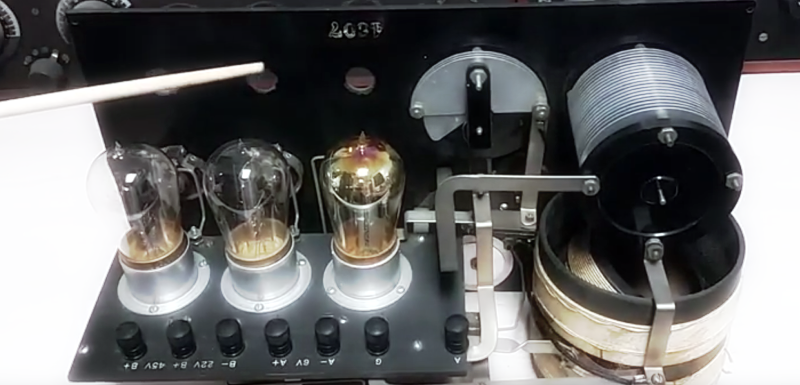Tube radios have a certain charm. Waiting for them to warm up, that glow of the filaments in a dark room. Tubes ruled radio for many decades. [Uniservo] posted a video about the history and technology behind the 1920’s era Clapp-Eastham C-3 radio. This is a three-tube regenerative receiver and was advanced for its day.
If you are worried he won’t open it up, don’t despair. Around the ten minute mark, your patience will be rewarded. Inside are three big tubes full of getter and bus bars instead of wires. Add to that the furniture-quality case, and this is a grand old radio.
One interesting thing about this receiver is that it uses a special kind of transformer known as a variocoupler where a coil rotates inside another to adjust the regeneration. It turned out that the tubes were newer than the radio, so [Uniservo] replaced them with more age-appropriate tubes.
Unfortunately, the radio is silent for now because of open audio transformers. We hope he’ll get it working and make another video of it actually operating.
Regenerative receivers have pretty good amplification performance with a low parts count. That’s because the amplifier operates near oscillation where the gain at the selected frequency is very high. It is pretty easy to build your own using technology a little newer than these tubes. If you want to dive into the theory, we’ve done that, too.
















Beautiful!
Actually, my grandfather’s radio is in a trunk in the garage.
It is an AA5 maybe from the 1960’s!
B^)
Radio never sounded so good. We had an old Grundig Majestic when I was growing up. The sounds that thing made were warm and beautiful. Music sounded better on it than anything I have heard since, and I have a pretty nice set-up here at home.
A lot of the audio problem starts at the radio station. MP3s, FLAC, etc for source material.
No amount of smoothing or whatever tom-foolery can fix that
Variable bit rate material should be banished from any commercial usage!
CDs weren’t that bad, mostly just the equipment they used to play them.
I can pull out some receivers from as far back as early 1970’s , when the everything was analogue From the Stations source material all the way to my receiver. Much easier on the ears back then.
The radio stations sound like crap on any unit nowdays.
Roughly 20 years ago, We had 2 PBS feed TV stations here.
One went (and bragged about it) to a “digital studio” (their words, not mine) before the other station.
After the one went digital, the sound was harsh & grainy even spoken word~news programming was atrocious(low bit rate).
I stopped watching the digital one after a while.
I would point out that in October 1914 Howard Armstrong received the patent the regenerative receiver.
He received the patent for the superheterodyne receiver about 1920.
The patent for superregeration was issued to him in 1922.
The patents about FM starred in 1933.
So while the regen was king in the twenties, the superhet is almost as old.
I don’t know what my grandfather used, but the only radios in his house in the sixties, his last decade, were commercially built superhets.
Michael
I’m wearing headphones and for a video about audio, its audio is terrible.
My father had a regenerative receiver and hacked a wind-up alarm clock to wake up to music. He forgot the main characteristic of regenerative radios, you have to adjust the amount of regeneration depending on how powerful the signal is, and the signal level varies with the time of day. He woke up to a very loud oscillating receiver.
Tube regenerative radios are awesome. They’re like analog haiku; there’s few parts but the results can vary depending on the quality of the components and the care used in assembly. Building a regenerative receiver is about 180 degrees from working in software/firmware, so radio-building can be a great change of pace.
It’s just too bad there isn’t more good radio on the HF bands… it seems its mostly religious stations or Alec Jones’ Infowars…
I was thinking ‘analog haiku? Are there digital haiku?’ but after checking I see this:
“Haiku is a free and open-source operating system compatible with the now discontinued BeOS.”
Also, who doesn’t like alex jones? Always fighting the government with much aplomb in an amusing fashion.
What Jones should do though is to learn Korean, and then start a radio station in SK. He can sell them emergency rations too.